Spatial Differentiation of Non-Grain Production on Cultivated Land and Its Driving Factors in Coastal China
Abstract
:1. Introduction
2. Materials and Methods
2.1. Concept Definition and Research Framework
2.1.1. Concept Definitions
2.1.2. Research Framework
2.2. The Study Area, Variable Selection and Data Processing
2.2.1. The Study Area
2.2.2. Selection of Variables
2.2.3. Data Source
2.3. Research Method
2.3.1. Spatial Auto-Correlation Analysis Method
2.3.2. Ordinary Least Square (OLS) Linear Regression Analysis
2.3.3. Geographically Weighted Regression (GWR)
3. Results
3.1. Overall Pattern of NGP in Coastal China
3.2. Spatial Distribution of NGP in Coastal China and Its Differentiation Characteristics
3.3. Main Driving Factors of NGP in Coastal China and Regional Differentiation
3.3.1. Main Driving Factors of NGP in Coastal China
3.3.2. Spatial Heterogeneity of the Driving Factors of NGP in Coastal China
4. Discussion
4.1. Analysis of the Causes of NGP and Regional Differentiation in Coastal China
4.2. The Potential Impact of NGP on China’s Food Security
4.3. How to Effectively Control NGP in Coastal China
5. Conclusions
Author Contributions
Funding
Institutional Review Board Statement
Informed Consent Statement
Data Availability Statement
Acknowledgments
Conflicts of Interest
References
- Chen, F.; Liu, J.N.; Chang, Y.Y.; Zhang, Q.; Yu, H.C.; Zhang, S.L. Spatial pattern differentiation of cultivated land non-grain conversion and its driving factors in china. China Land Sci. 2021, 35, 35–45. [Google Scholar]
- Zhou, Y.; Li, X.H.; Liu, Y.S. Land use change and driving factors in rural China during the period 1995–2015. Land Use Policy 2020, 99, 105048. [Google Scholar] [CrossRef]
- Liu, Y.S.; Li, Y.H. Revitalize the world’s countryside. Nature 2017, 548, 275–277. [Google Scholar] [CrossRef] [PubMed]
- Li, C.; Wang, W.; Li, W.C. Effect of non-grain utilization on cultivated land quality. China Land 2021, 3, 17–19. [Google Scholar]
- Zhang, L.X.; Song, B.; Chen, B. Emergy-based analysis of four farming systems: Insight into agricultural diversification in rural China. J. Clean. Prod. 2012, 28, 33–44. [Google Scholar] [CrossRef]
- Prishchepov, A.V.; Müller, D.; Dubinin, M.; Baumann, M.; Radeloff, V.C. Determinants of agricultural land abandonment in post-Soviet European Russia. Land Use Policy 2013, 30, 873–884. [Google Scholar] [CrossRef] [Green Version]
- Su, Y.; Li, C.L.; Wang, K.; Deng, J.S.; Shahtahmassebi, A.R.; Zhang, L.P.; Ao, W.J.; Guan, T.; Pan, Y.; Gan, M.Y. Quantifying the spatiotemporal dynamics and multi-aspect performance of NGP during 2000–2015 at a fine scale. Ecol. Indic. 2019, 101, 410–419. [Google Scholar] [CrossRef]
- Van Vliet, J.; de Groot, H.L.F.; Rietveld, P.; Verburg, P.H. Manifestations and underlying drivers of agricultural land use change in Europe. Landsc. Urban Plan. 2015, 133, 24–36. [Google Scholar] [CrossRef] [Green Version]
- Zhong, T.Y.; Zhu, Q.; Huang, X.J.; Zhao, Y.T.; Zhou, Y.; Zhao, Z.H. Impact of the top-down quota-oriented farmland preservation planning on the change of urban land-use intensity in China. Habitat Int. 2018, 77, 71–79. [Google Scholar] [CrossRef]
- Armsworth, P.R.; Daily, G.C.; Kareiva, P. Land market feedbacks can undermine biodiversity conservation. Proc. Natl. Acad. Sci. USA 2006, 103, 5403–5408. [Google Scholar] [CrossRef] [Green Version]
- Lewis, D.J.; Wu, P.J. Targeting incentives to reduce habitat fragmentation. Am. J. Agric. Econ. 2010, 91, 1080–1096. [Google Scholar] [CrossRef] [Green Version]
- Xu, G.; Huang, X.; Zhong, T.; Yi, C.; Jin, Y. Assessment on the effect of city arable land protection under the implementation of China’s National General Land Use Plan (2006–2020). Habitat Int. 2015, 49, 466–473. [Google Scholar] [CrossRef]
- Wu, Y.; Zhang, X.; Skitmore, M.; Song, Y.; Hui, E.C. Industrial land price and its impact on urban growth: A Chinese case study. Land Use Policy 2014, 36, 199–209. [Google Scholar] [CrossRef] [Green Version]
- Lyle, G.; Bryan, B.A.; Ostendorf, B. Identifying the spatial and temporal variability of economic opportunity costs to promote the adoption of alternative land uses in grain growing agricultural areas: An Australian example. J. Environ. Manag. 2015, 155, 123–135. [Google Scholar] [CrossRef] [PubMed]
- Li, H.; Wu, Y.; Huang, X.; Sloan, M.; Skitmore, M. Spatial-temporal evolution and classification of marginalization of cultivated land in the process of urbanization. Habitat Int. 2017, 61, 1–8. [Google Scholar] [CrossRef] [Green Version]
- Chaifetz, A.; Jagger, P. 40 Years of dialogue on food sovereignty: A review and a look ahead. Glob. Food Secur. 2014, 3, 85–91. [Google Scholar] [CrossRef]
- Zambon, I.; Serra, P.; Salvia, R. Fallow land, recession and Socio-Demographic local contexts: Recent dynamics in a mediterranean urban fringe. Agriculture 2018, 8, 159. [Google Scholar] [CrossRef] [Green Version]
- Zhu, G.F.; Li, X.C.; Shi, Y.R.; Zhang, Y.; Li, Z.Y. Comparison of crop rotation and land fallow between China and foreign countries and it’s policy implications. Chin. J. Agric. Resour. Reg. Plan. 2018, 39, 35–41. [Google Scholar]
- Han, H.Y.; Lin, H. Patterns of agricultural diversification in China and its policy implications for agricultural modernization. Int. J. Environ. Res. Public Health 2021, 18, 4978. [Google Scholar] [CrossRef]
- Barnes, A.P.; Hansson, H.; Manevska-Tasevska, G. The influence of diversification on long-term viability of the agricultural sector. Land Use Policy 2015, 49, 404–412. [Google Scholar] [CrossRef]
- Angelo, C. Brazil’s fund for low-carbon agriculture lies fallow. Nature 2012. [Google Scholar] [CrossRef]
- Kong, X.B. Cultivated land “Non-grain” problem, cause and countermeasure. China Land 2020, 11, 17–19. (In Chinese) [Google Scholar]
- Zhu, H.Z. A review of the research on non-grain conversion of farmland transfer and its impact on food security. Econ. Manag. J. 2016, 17, 82–84. [Google Scholar]
- Zhu, D.; Gao, Y. An analysis of farmers’s declining will to produce grains and recession of grain producing-a survey of 346 households in 32 villages from Fujian, Jiangxi, Hubei and Zhejiang province. J. Jimei Univ. (Philos. Soc. Sci.) 2013, 16, 41–48. [Google Scholar]
- Deng, X.Z.; Huang, J.K.; Rozelle, S.; Zhang, J.P.; Li, Z.H. Impact of urbanization on cultivated land changes in China. Land Use Policy 2015, 45, 1–7. [Google Scholar] [CrossRef]
- Seto, K.C.; Kaufmann, R.K.; Woodcock, C.E. Landsat reveals China’s farmland reserves, but they’re vanishing fast. Nature 2000, 406, 121. [Google Scholar] [CrossRef]
- Liao, F.Z.; Liao, J.Y.; Yang, C. Research on the problems and countermeasures of “Non-grain” in farmland transfer. Trib. Study 2015, 31, 37–40. [Google Scholar]
- Zhou, Y.L.; Song, Y.Q. Causes and solving measures of non-food during the process of farmland circulation: From the perspective of national food security. Guangdong Agric. Sci. 2016, 43, 189–192. [Google Scholar]
- Xiao, J.Z.; Zhao, X.J.; Ye, Y. Analysis of temporal and spatial evolution and influence factors of cultivated land in Pearl River Delta based on GIS. In IOP Conference Series: Earth and Environmental Science, Changsha, China, 18–20 September 2020; IOP Publishing: Bristol, UK, 2020; Volume 615, p. 012042. [Google Scholar]
- Qiu, L.F.; Zhu, J.X.; Pan, Y.; Wu, S.H.; Dang, Y.X.; Xu, B.G.; Yang, H. The positive impacts of landscape fragmentation on the diversification of agricultural production in Zhejiang province, China. J. Clean. Prod. 2020, 251, 119722. [Google Scholar] [CrossRef]
- Huang, W.; Yu, Z.X. Current Situations and Recommendations for Non-grain Tendency of Farmland in Anhui Province. Asian Agric. Res. 2016, 4, 50–57. [Google Scholar]
- Chen, S.; Zeng, F.; Liu, H.; Xu, H. Factors affecting farmers’ willingness to grow grain in key grain-producing areas: Based on the investigation of 475 rural households of Hunan Province. J. Hum. Agric. Univ. (Soc. Sci.) 2012, 13, 29–35. [Google Scholar]
- Tang, J. Empirical analysis on influencing factors of peasant households’ willingness to grow crops-the survey data of 520 peasant households from Shanxi province. J. Jiangxi Agric. Univ. 2013, 12, 438–444. [Google Scholar]
- Gu, L. An analysis on influencing factors of farmers’ willingness to produce grains in major grain producing areas. J. Jiangsu Agric. Sci. 2013, 41, 405–407. [Google Scholar]
- Lang, W.; Long, Y.; Chen, T.T. Rediscovering Chinese cities through the lens of land-use patterns. Land Use Policy 2018, 79, 362–374. [Google Scholar] [CrossRef]
- Stampini, M.; Davis, B. Does nonagricultural labor relax farmers’ credit constraints? Evidence from longitudinal data for Vietnam. Agric. Econ. 2009, 40, 177–188. [Google Scholar] [CrossRef]
- Wang, Q.Z.; Guan, Q.Y.; Lin, J.K.; Luo, H.P.; Tan, Z.; Ma, Y.R. Simulating land use/land cover change in an arid region with the coupling models. Ecol. Indic. 2021, 122, 107231. [Google Scholar] [CrossRef]
- Bekele, A.E.; Drabik, D.; Dries, L.; Heijman, W. Large-scale land investments, household displacement, and the effect on land degradation in semiarid agro-pastoral areas of Ethiopia. Land Degrad. Dev. 2021, 32, 777–791. [Google Scholar] [CrossRef]
- Yang, R.Z.; Chen, Y.J.; Yi, X.Y.; Fang, L.N. The causes and countermeasures on the excessive “Non-grain” tendency in the process of land transfer. Chin. J. Agric. Resour. Reg. Plan. 2012, 33, 14–17. [Google Scholar]
- Zhang, W.; Jin, W. In Some Areas, only 6% of the Land Leased to Grow Grain Was Used. National Business Daily. 2013. Available online: http://www.nbd.com.cn/articles/2013-12-24/797403.html (accessed on 22 November 2021).
- Widowaty, Y.; Artanto, I.O. Protection of Agricultural Land Sustainable Food for the Realization of Food Security in the Special Region of Yogyakarta; Atlantis Press: Paris, France, 2018; pp. 36–41. [Google Scholar]
- Maryati, S.; Humaira, A.N.S.; Pratiwi, F. Spatial Pattern of Agricultural Land Conversion in West Java Province. Earth Environ. Sci. 2018, 131, 012034. [Google Scholar] [CrossRef] [Green Version]
- Ziegler, A.D.; Fox, J.M.; Xu, J. Agriculture. The rubber juggernaut. Science 2009, 324, 1024–1025. [Google Scholar] [CrossRef]
- Rui, X.; Su, S.; Mai, G.; Zhang, Z.; Yang, C. Quantifying determinants of cash crop expansion and their relative effects using logistic regression modeling and variance partitioning. Int. J. Appl. Earth Obs. Geoinf. 2015, 34, 258–263. [Google Scholar]
- Li, M.H. Research on non-grainization of cultivated land in grain-producing country in Henan province under new situation. Research Institute of Management Science and Industrial Engineering. In Proceedings of the 2017 4th International Conference on Education, Management and Computing Technology, Hangzhou, China, 15–16 April 2017; Chu, X., Ed.; Volume 101, pp. 953–957. [Google Scholar]
- Baumann, M.; Kuemmerle, T.; Elbakidze, M.; Ozdogan, M.; Radeloff, V.C.; Keuler, N.S.; Prishchepov, A.V.; Kruhlov, I.; Hostert, P. Patterns and drivers of post-socialist farmland abandonment in Western Ukraine. Land Use Policy 2011, 28, 552–562. [Google Scholar] [CrossRef]
- Yao, X.W.; Zeng, J.; Li, W.J. Spatial correlation characteristics of urbanization and land ecosystem service value in Wuhan Urban Agglomeration. Trans. Chin. Soc. Agric. Eng. 2015, 31, 249–256. [Google Scholar]
- Anuja, A.R.; Kumar, A.; Saroj, S. The impact of crop diversification towards high-value crops on economic welfare of agricultural households in eastern India. Curr. Sci. 2020, 118, 1575–1582. [Google Scholar] [CrossRef]
- Geng, T.W.; Chen, H.; Zhang, H.; Shi, Q.Q.; Liu, D. Spatiotemporal evolution of land ecosystem service value and its influencing factors in Shaanxi province based on GWR. J. Nat. Resour. 2020, 35, 1714–1727. [Google Scholar]
- Ma, Y.; Tong, Y.; Ren, J.; Liu, J. Spatial-temporal pattern and driving factors of public participation in environmental regulation: Taking the Yangtze River economic belt as an example. Chin. Geogr. Sci. 2018, 38, 1799–1808. [Google Scholar]
- Chen, M.; Xiao, H.; He, W.; Deng, A. Empirical analysis on the influencing factors of farm household’s behavior in land transfer-investigation on the circulation of farmland of 1396 households in Jiangxi province. J. Nat. Resour. 2008, 23, 369–374. [Google Scholar]
- Zhao, X.; Zheng, Y.; Huang, X. The effect of urbanization and farmland transfer on the spatial patterns of non-grain farmland in China. Sustainability 2017, 9, 1438. [Google Scholar] [CrossRef] [Green Version]
- Pan, J.H.; Zhang, J.H.; Hu, Y.X. Spatial-temporal pattern of per capital grain possession and its driving forces in Gansu Province. J. Nat. Resour. 2016, 31, 124–134. [Google Scholar]
- Su, B.; Li, Y.; Li, L. How does nonfarm employment stability influence farmers’ farmland transfer decisions? Implications for China’s land use policy. Land Use Policy 2018, 74, 66–72. [Google Scholar] [CrossRef]
- Camacho-Valdez, V.; Ruiz-Luna, A.; Ghermandi, A.; Nunes, P.A.L.D. Valuation of ecosystem services provided by coastal wetlands in northwest Mexico. Ocean Coast. Manag. 2013, 2, 17. [Google Scholar] [CrossRef]
- Su, S.; Xiao, R.; Li, D. Impacts of transportation routes on landscape diversity: A comparison of different route types and their combined effects. Environ. Manag. 2014, 53, 636–647. [Google Scholar] [CrossRef]
- Yang, Q.; Zhang, D.J. The influence of agricultural industrial policy on non-grain production of cultivated land: A case study of the “one village, one product” strategy implemented in Guanzhong Plain of China. Land Use Policy. 2021, 108, 105579. [Google Scholar] [CrossRef]
- Kogo, B.K.; Kumar, L.; Koech, R. Analysis of spatio-temporal dynamics of land use and cover changes in Western Kenya. Geocarto Int. 2021, 36, 376–391. [Google Scholar] [CrossRef]
- Chang, Y.Y.; Liu, J.N.; Zhang, Q.; Yu, H.C.; Bian, Z.F.; Chen, F. Spatial pattern differentiation of cultivated land non-grain conversion in major grain-producing areas. J. Agric. Resour. Environ. 2021, 7, 337. [Google Scholar]
- Brunsdon, C.; Fotheringham, S.; Charlton, M. Geographically Weighted Regression. J. R. Stat. Soc. Ser. A 1998, 47, 431–443. [Google Scholar] [CrossRef]
- Li, J.; Zhou, K.; Dong, H.; Xie, B. Cultivated land change, driving forces and its impact on landscape pattern changes in the Dongting Lake Basin. Int. J. Environ. Res. Public Health 2020, 17, 7988. [Google Scholar] [CrossRef]
- Hu, Y. An analysis of land-use and land-cover change in the Zhujiang–Xijiang Economic Belt, China, from 1990 to 2017. Appl. Sci. 2018, 8, 1524. [Google Scholar] [CrossRef] [Green Version]
- Dadashpoor, H.; Azizi, P.; Moghadasi, M. Land use change, urbanization, and change in landscape pattern in a metropolitan area. Sci. Total Environ. 2019, 655, 707–719. [Google Scholar] [CrossRef]
- Song, W.; Liu, M.L. Farmland Conversion decreases regional and national land quality in China. Land Degrad. Dev. 2017, 28, 459–471. [Google Scholar] [CrossRef]
- Xiao, D.Q.; Xu, X.C.; Duan, L.; Lee, J.Y. Spatial-temporal analysis of injury severity with Geographically Weighted Panel Logistic Regression Model. J. Adv. Transport. 2019, 8, 8521649. [Google Scholar] [CrossRef]
- Meraner, M.; Polling, B.; Finger, R. Diversification in peri-urban agriculture: A case study in the Ruhr metropolitan region. J. Land Use Sci. 2018, 13, 284–300. [Google Scholar] [CrossRef] [Green Version]
- Lu, C.X.; Liu, A.M.; Xiao, Y.; Liu, X.J.; Xie, G.D.; Cheng, S.K. Changes in China’s grain production pattern and the effects of urbanization and dietary structure. J. Resour. Ecol. 2020, 11, 358–365. [Google Scholar]
- Li, W.B.; Wang, D.Y.; Liu, S.H.; Zhu, Y.L. Measuring urbanization-occupation and internal conversion of peri-urban cultivated land to determine changes in the peri-urban agriculture of the black soil region. Ecol. Indic. 2019, 102, 328–337. [Google Scholar] [CrossRef]
- Xiao, L.Q.; Chen, W.; Wu, Q.; MA, S.H. Impact of cultivated land quantity change on grain productive capacity of Yangtze River Delta in the next 10 years-from the perspective of cultivated land quality grade. J. Nat. Resour. 2012, 27, 565–576. [Google Scholar]
- Leng, Z.H.; Wang, Y.N.; Hou, X.S. Structural and efficiency effects of land transfers on food planting: A comparative perspective on north and south of China. Sustainability 2021, 13, 3327. [Google Scholar] [CrossRef]
- Wang, J.Y.; Xin, L.J.; Wang, Y.H. How farmers’ non-agricultural employment affects rural land circulation in China? J. Geogr. Sci. 2020, 30, 378–400. [Google Scholar] [CrossRef]
- Li, S.; Nadolnyak, D.; Hartarska, V. Agricultural land conversion: Impacts of economic and natural risk factors in a coastal area. Land Use Policy 2019, 80, 380–390. [Google Scholar] [CrossRef]
- Long, H.; Qu, Y. Land use transitions and land management: A mutual feedback perspective. Land Use Policy 2018, 74, 111–120. [Google Scholar] [CrossRef]
- Chen, F.; Yu, M.; Zhu, F.W.; Shen, C.Y.; Zhang, S.L.; Yang, Y.J. Rethinking rural transformation caused by comprehensive land consolidation: Insight from program of whole village restructuring in Jiangsu province, China. Sustainability 2018, 10, 2029. [Google Scholar] [CrossRef] [Green Version]
- Yu, H.C.; Zeng, S.Y.; Wang, Q.B.; Dai, J.; Bian, Z.F.; Chen, F. Forecast on China’s cultivated land protection baseline in the new era by multi-scenario simulations. Res. Sci. 2021, 43, 1222–1233. [Google Scholar]
- Liang, X.; Jin, X.; Sun, R.; Bo, H.; Liu, J.; Zhou, Y. A typical phenomenon of cultivated land use in China’s economically developed areas: Anti-intensification in Jiangsu Province. Land Use Policy 2021, 102, 105223. [Google Scholar] [CrossRef]
- Wen, Z.; Zheng, H.; Zhao, H.; Ouyang, Z.Y. The mediatory roles of species diversity and tree height diversity for linking the impact of land tensity on soil erosion. Land Degrad. Dev. 2020, 32, 1127–1134. [Google Scholar] [CrossRef]
- Hautier, Y.; Isbell, F.; Borer, E.T.; Seabloom, E.W. Local loss and spatial homogenization of plant diversity reduce ecosystem multifunctionality. Nat. Ecol. Evol. 2018, 2, 50–56. [Google Scholar] [CrossRef] [PubMed]
- Xie, H.; Wang, G.G.; Yu, M. Ecosystem multifunctionality is highly related to the shelterbelt structure and plant species diversity in mixed shelterbelts of eastern China. Glob. Ecol. Conserv. 2018, 16, e00470. [Google Scholar] [CrossRef]
- Koch, J.; Schaldach, R.; Göpel, J. Can agricultural intensification help to conserve biodiversity? A scenario study for the African continent. J. Environ. Manag. 2019, 247, 29–37. [Google Scholar] [CrossRef]
- Zabel, F.; Delzeit, R.; Schneider, J.M.; Seppelt, R.; Mauser, W.; Václavík, T. Global impacts of future cropland expansion and intensification on agricultural markets and biodiversity. Nat. Commun. 2019, 10, 2844. [Google Scholar] [CrossRef] [Green Version]
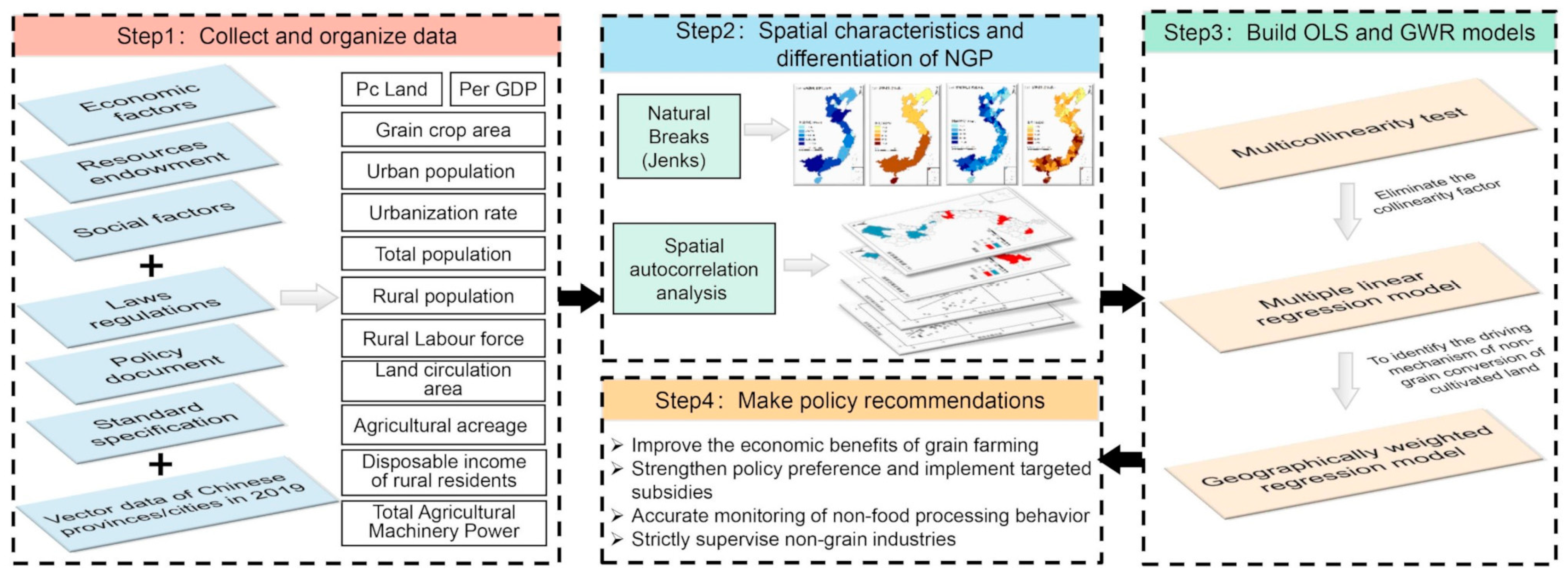

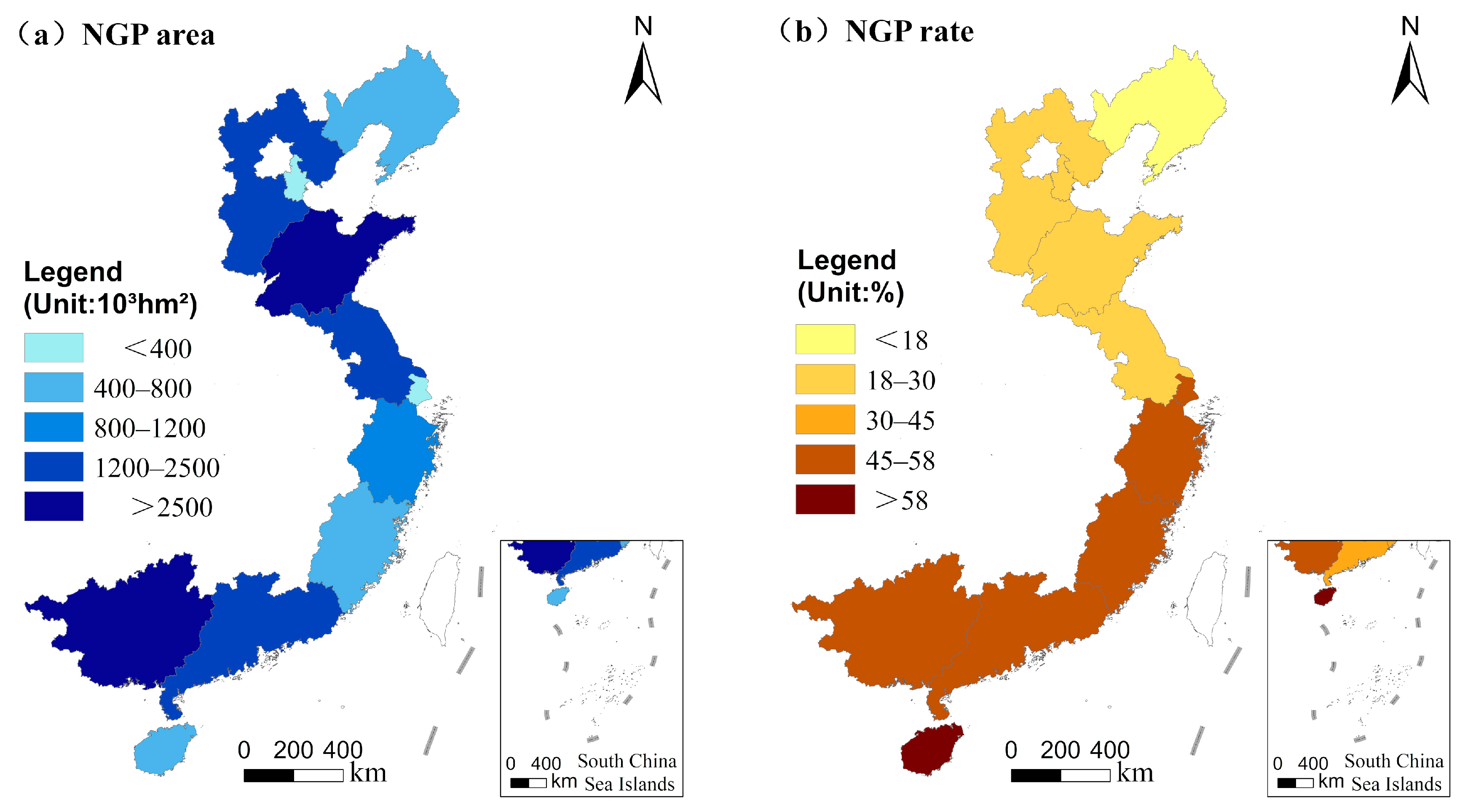
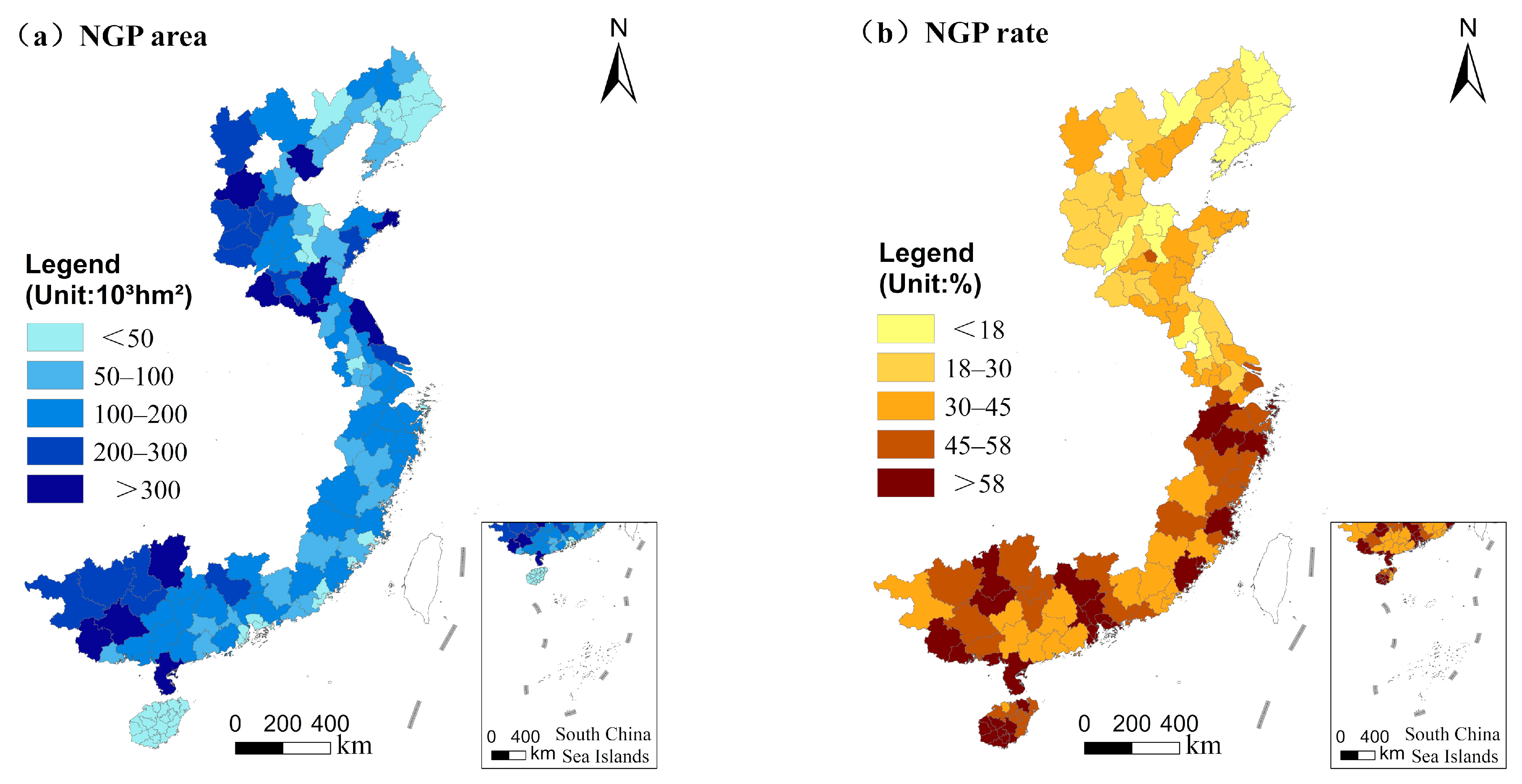
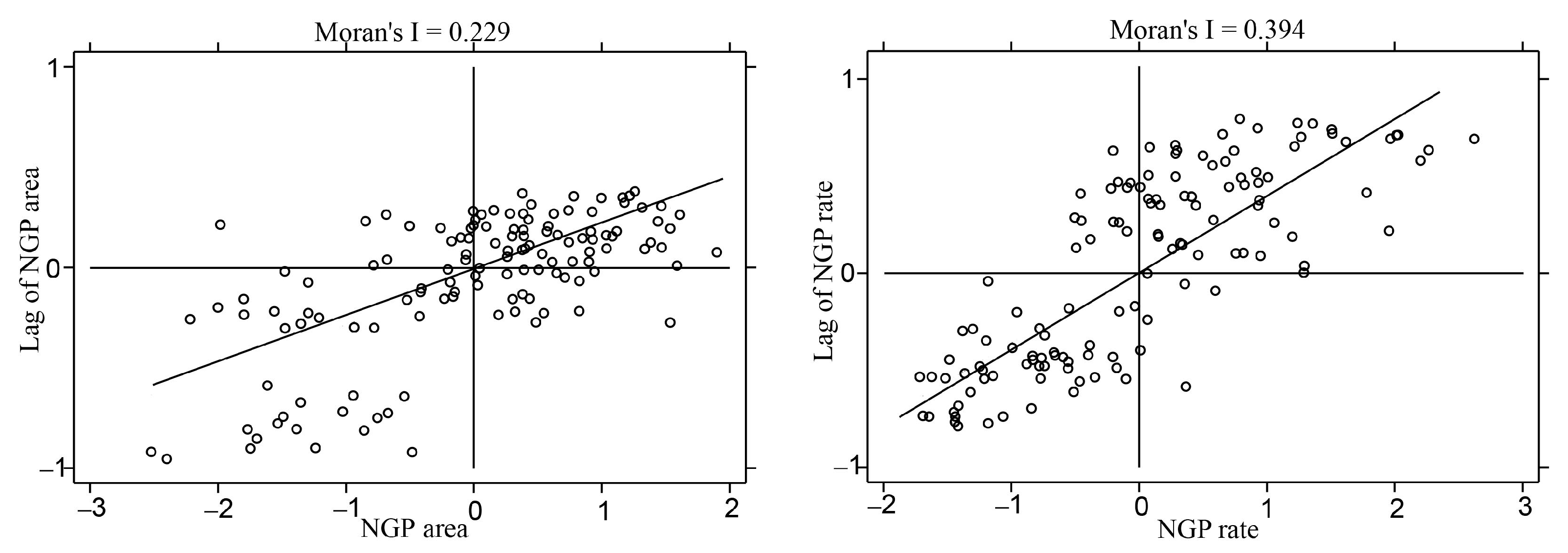
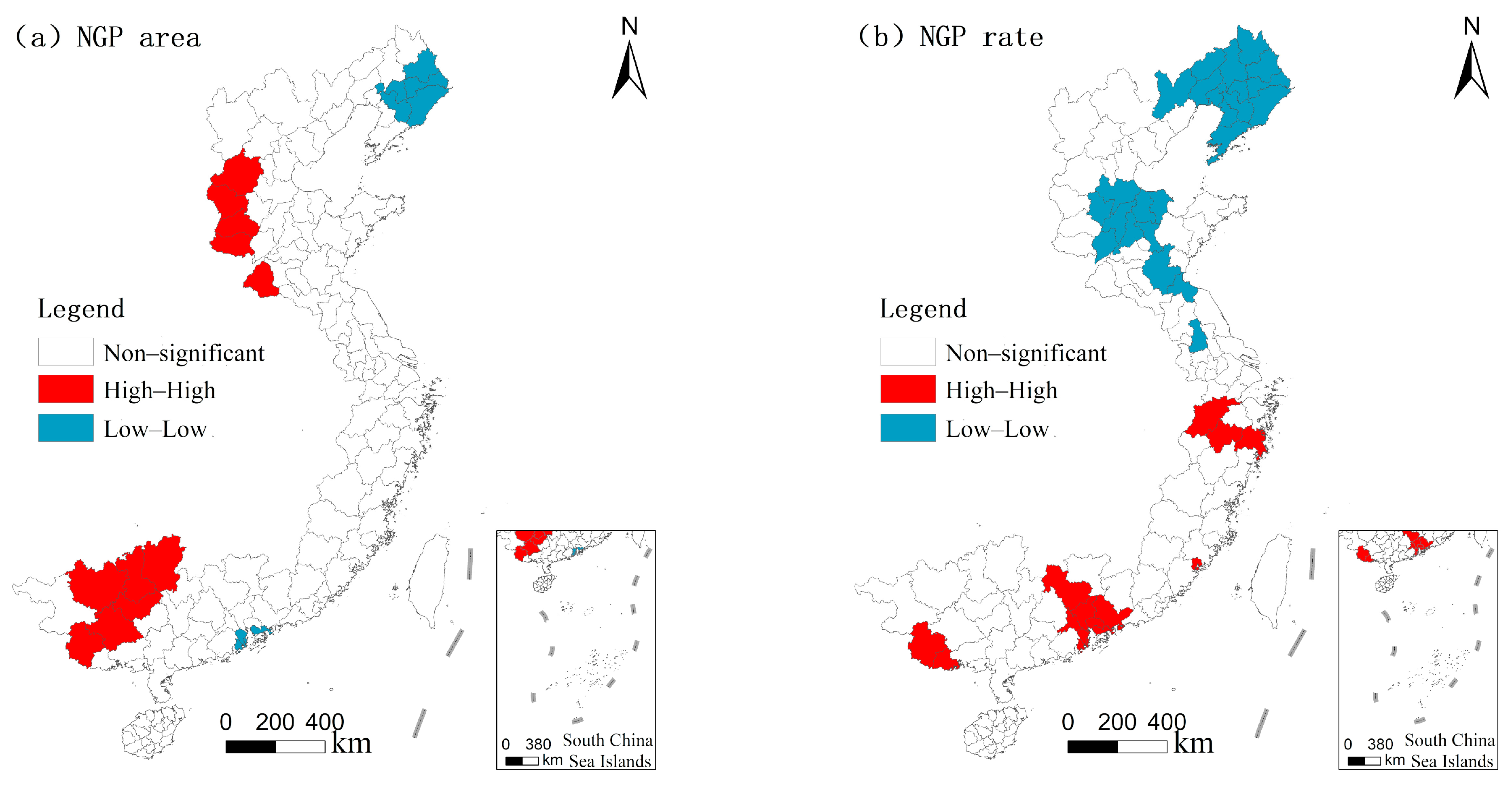
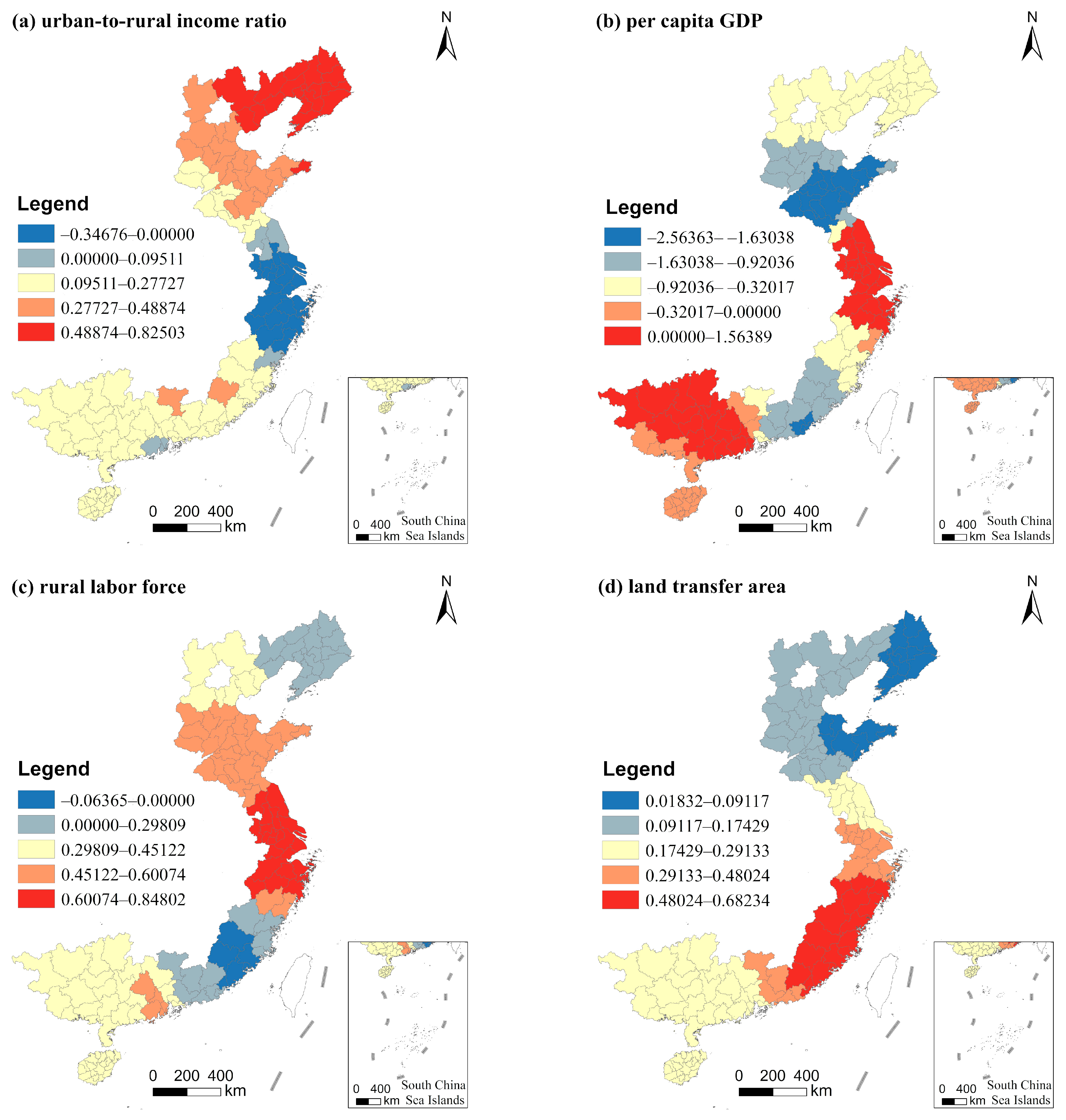
| Indexes | Factors | Unit | Label | Indexes | Factors | Unit | Label |
|---|---|---|---|---|---|---|---|
| Economic indexes | Per capita GDP | CNY | x1 | Social indexes | Agricultural machinery power | 104 kW | x8 |
| Actual use foreign investment | 106 $ | x2 | Urban population | per | x9 | ||
| Urban-to-rural disposable income ratio | / | x3 | Rural population | per | x10 | ||
| Resource endowment | >10 °C accumulated temperature | °C | x4 | Rural labor force | per | x11 | |
| Slope | % | x5 | Urbanization rate | % | x12 | ||
| Grain-sowing area | hm2 | x6 | Policy indexes | Land transfer area | hm2 | x13 | |
| Cultivated area per rural labor | hm2/per | x7 | Agricultural cooperatives number | Number | x14 |
| Explanatory Variable | Coefficient | Standard Error | t | Sig. F | Collinearity Statistics | Importance-Based Rank | ||
|---|---|---|---|---|---|---|---|---|
| Tolerance | VIF | Contribution Degree | Ranking | |||||
| Interception | 6.786 | 2.114 | 3.210 | 0.002 ** | ||||
| x1 | 0.239 | 0.089 | 3.293 | 0.001 *** | 0.326 | 1.767 | 0.182 | 2 |
| x2 | 0.248 | 0.492 | 1.569 | 0.077 * | 0.189 | 5.295 | 0.069 | 6 |
| x3 | 0.373 | 0.092 | 4.643 | 0.000 *** | 0.221 | 2.532 | 0.301 | 1 |
| x8 | 0.284 | 0.176 | 1.781 | 0.072 * | 0.171 | 3.29 | 0.076 | 5 |
| x11 | 0.129 | 0.175 | 3.215 | 0.001 *** | 0.302 | 3.267 | 0.172 | 3 |
| x12 | −1.134 | 0.538 | −2.107 | 0.035 ** | 0.414 | 2.255 | 0.028 | 7 |
| x13 | 0.356 | 0.368 | 1.987 | 0.059 * | 0.218 | 2.412 | 0.109 | 4 |
| OLS diagnosis | Joint F-value | 0.0000 *** | ||||||
| Joint Chi-square value | 212.4581, 0.0000 *** | |||||||
| Model | AICc | Goodness of Fit (R2) | Adjusted Goodness of Fit (R2) | p Value |
|---|---|---|---|---|
| OLS | 222.326 | 0.714 | 0.704 | 0 |
| GWR | 138.266 | 0.905 | 0.872 | 0 |
Publisher’s Note: MDPI stays neutral with regard to jurisdictional claims in published maps and institutional affiliations. |
© 2021 by the authors. Licensee MDPI, Basel, Switzerland. This article is an open access article distributed under the terms and conditions of the Creative Commons Attribution (CC BY) license (https://creativecommons.org/licenses/by/4.0/).
Share and Cite
Sun, Y.; Chang, Y.; Liu, J.; Ge, X.; Liu, G.-J.; Chen, F. Spatial Differentiation of Non-Grain Production on Cultivated Land and Its Driving Factors in Coastal China. Sustainability 2021, 13, 13064. https://doi.org/10.3390/su132313064
Sun Y, Chang Y, Liu J, Ge X, Liu G-J, Chen F. Spatial Differentiation of Non-Grain Production on Cultivated Land and Its Driving Factors in Coastal China. Sustainability. 2021; 13(23):13064. https://doi.org/10.3390/su132313064
Chicago/Turabian StyleSun, Yan, Yuanyuan Chang, Junna Liu, Xiaoping Ge, Gang-Jun Liu, and Fu Chen. 2021. "Spatial Differentiation of Non-Grain Production on Cultivated Land and Its Driving Factors in Coastal China" Sustainability 13, no. 23: 13064. https://doi.org/10.3390/su132313064
APA StyleSun, Y., Chang, Y., Liu, J., Ge, X., Liu, G.-J., & Chen, F. (2021). Spatial Differentiation of Non-Grain Production on Cultivated Land and Its Driving Factors in Coastal China. Sustainability, 13(23), 13064. https://doi.org/10.3390/su132313064






